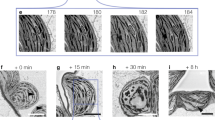Abstract
Gravitropism in plants is one of the most controversial issues. In the most wildly accepted starch-statolith hypothesis the sedimentation movement of amyloplasts in the gravisensing columella cells primarily triggers the asymmetric distribution of auxin which leads to the differential growth of the plant root. It has been gradually recognized that the inhomogeneous structures in statocytes arising from intracellular components such as cytoskeletons significantly affect the complex movements of amyloplasts and the final gravimorphogenesis. In this letter, we implement a diffusive dynamics measurement and inplanta microrheological analysis of amyloplasts in the wild-type plants and actin cytoskeleton mutants for the first time. We found that the intracellular environment of columella cells exhibits the spatial heterogeneity and the cage-confinement on amyloplasts which is the typically characteristics in colloidal suspensions. By comparing the distinct diffusive dynamics of amyloplasts in different types of plants with the behaviors of colloidal systems in different states, we quantitatively characterized the influence of the actin organization dominated intracellular envoronments on the amyloplast movements. Furthermore, the cage-confinement strength was measured by calculating the spatial fluctuation of local apparent viscosity within the columella cells. Finally, a linear association between the initial mechanical stimulation in the columella cells the subsequent intercellular signal transduction and the final gravity response was observed and a possible gravity sensing mechanism was suggested. It suggests the existence of a potential gravity-sensing mechanism that dictates a linear frustration effect of the actin cytoskeleton on the conversion of the mechanical stimulation of amyloplasts into gravitropic signals.







Similar content being viewed by others
References
Band, L.R., Wells, D.M., Fozard, J.A., Ghetiu, T., French, A.P., et al.: Systems analysis of auxin transport in the Arabidopsis root apex. Plant Cell 26, 862–875 (2014)
Basu, D., Le, J., El-Essal Sel, D., et al.: DISTORTED3/SCAR2 is a putative arabidopsis WAVE complex subunit that activates the Arp2/3 complex and is required for epidermal morphogenesis. Plant cell 17, 502–524 (2005)
Blancaflor, E.B.: Regulation of plant gravity sensing and signaling by the actin cytoskeleton. Am. J. Bot. 100, 143–152 (2013)
Brunoud, G., Wells, D.M., Oliva, M., Larrieu, A., Mirabet, V., et al.: A novel sensor to map auxin response and distribution at high spatio-temporal resolution. Nature 482, 103–106 (2012)
Chaudhuri, O., Parekh, S.H., Fletcher, D.A.: Reversible stress softening of actin networks. Nature 445, 295–298 (2007)
Crocker, J.C., Valentine, M.T., Weeks, E.R., et al.: Two-point microrheology of inhomogeneous soft materials. Phys. Rev. Lett. 85, 888–891 (2000)
Hou, G., Kramer, V.L., Wang, Y.-S., et al.: The promotion of gravitropism in Arabidopsis roots upon actin disruption is coupled with the extended alkalinization of the columella cytoplasm and a persistent lateral auxin gradient. Plant J. 39, 113–125 (2004)
Hunter, G.L., Weeks, E.R.: The physics of the colloidal glass transition. Rep. Prog. Phys. 75, 066501 (2012)
Le, J., El-Assal Sel, D., Basu, D., Saad, M.E., Szymanski, D.B.: Requirements for Arabidopsis ATARP2 and ATARP3 during epidermal development. Curr. Biol. 13, 1341–1347 (2003)
Leitz, G., Kang, B.-H., Schoenwaelder, M.E.A., Staehelin, L.A.: Statolith sedimentation kinetics and force transduction to the cortical endoplasmic reticulum in gravity-sensing Arabidopsis columella cells. Plant Cell 21, 843–860 (2009)
Levine, A.J., Lubensky, T.C.: One- and two-particle microrheology. Phys. Rev. Lett. 85, 1774–1777 (2000)
Marcus, A.H., Schofield, J., Rice, S.A.: Experimental observations of non-Gaussian behavior and stringlike cooperative dynamics in concentrated quasi-two-dimensional colloidal liquids. Phys. Rev. E 60, 5725–5736 (1999)
Mizuno, D., Tardin, C., Schmidt, C.F., Mackintosh, F.C.: Nonequilibrium mechanics of active cytoskeletal networks. Science 315, 370–373 (2007)
Morita, M.T.: Directional Gravity Sensing in Gravitropism. Annu. Rev. Plant Biol. 61, 705–720 (2010)
Palmieri, M., Kiss, J.Z.: Disruption of the F-actin cytoskeleton limits statolith movement in Arabidopsis hypocotyls. J. Exp. Bot. 56, 2539–2550 (2005)
Perbal, G., Driss-Ecole, D.: Mechanotransduction in gravisensing cells. Trends Plant Sci. 8, 498–504 (2003)
Squires, T.M., Mason, T.G.: Fluid mechanics of microrheology. Annu. Rev. Fluid Mech. 42, 413 (2009)
Swarup, R., Kramer, E.M., Perry, P., et al.: Root gravitropism requires lateral root cap and epidermal cells for transport and response to a mobile auxin signal. Nat. Cell Biol. 7, 1057–1065 (2005)
Toyota, M., Ikeda, N., Sawai-Toyota, S., et al.: Amyloplast displacement is necessary for gravisensing in Arabidopsis shoots as revealed by a centrifuge microscope. Plant J. 76, 648–660 (2013)
Vanneste, S., Auxin, F.J.: A trigger for change in plant development. Cell 136, 1005–1016 (2009)
Waigh, T.A.: Microrheology of complex fluids. Rep. Prog. Phys. 68, 685–742 (2005)
Weeks, E.R., Crocker, J.C., Levitt, A.C., Schofield, A., Weitz, D.A.: Science 287, 627 (2000)
Wirtz, D.: Particle-tracking microrheology of living cells: principles and applications. Annu. Rev. Biophys. 38, 301–326 (2009)
Zheng, Z., Han, Y.: Self-diffusion in two-dimensional hard ellipsoid suspensions. J. Chem. Phys. 133, 124509 (2010)
Zheng, Z., Ni, R., Wang, F., Dijkstra, M., Wang, Y., Han, Y.: Structural signatures of dynamic heterogeneities in monolayers of colloidal ellipsoids. Nat. Commun. 5, 3829 (2014)
Zheng, Z., Wang, F., Han, Y.: Glass transitions in quasi-two-dimensional suspensions of colloidal ellipsoids. Phys. Rev. Lett. 107, 065702 (2011)
Acknowledgments
This work was supported by the National Basic Research Program of China (Grant No. 2011CB710902, 2011CB710901) and NSFC grants 11104286 and 11372314.
Author information
Authors and Affiliations
Corresponding author
Rights and permissions
About this article
Cite this article
Zheng, Z., Zou, J., Li, H. et al. Dynamical and Microrheological Analysis of Amyloplasts in the Plant Root Gravity-Sensing Cells. Microgravity Sci. Technol. 27, 485–493 (2015). https://doi.org/10.1007/s12217-015-9445-x
Received:
Accepted:
Published:
Issue Date:
DOI: https://doi.org/10.1007/s12217-015-9445-x




